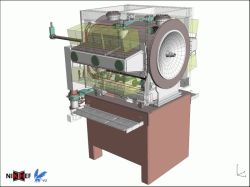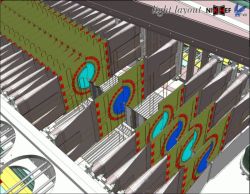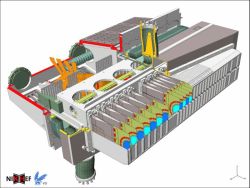A short VELO presentation
The Vertex Locator (Fig.1) will provide precise measurements on straight tracks
(no magnetic field) in an area close to the LHCb interaction region.

1. The Vertex Locator
To this end, it is constituted of two series of 21 stations (Fig.2), each station
consisting into two plane silicon sensors (shown in blue on fig. 2): one giving the
R position, the other the Phi position of the track. Each sensor is divided into a
certain number of silicon strips. A particle passing trough a sensor will let charge
into the strips, then these charges will be collected to form clusters, and clusters
into different sensors will be used to fit the tracks.

2. VeLo stations
As we said before, the distance between the sensors and the beam is very small
(only 8 mm). In fact it is smaller than LHC aperture during injection, so that
the stations should be able to retract during this phase.
Furthermore, in order to minimize the material seen by the particles during
their journey trough the VELO, the stations are into two aluminium boxes
(one for each side) at a very low pressure (less than 10
-4 mbar). These
boxes (shown in part on fig. 3) are also shielding the stations against beam RF pickups.

3. Open RF box
Precise track measurements are needed as soon as the LEVEL 1 of
LHCb trigger.
Indeed this LEVEL is mainly based on secondary vertex reconstruction.
That means that we need to know precisely the position of each sensors
at each moment during the run. This is the role of the alignment. One of
the most critical point concerning LHCb alignment is that the detector is
moved between each run. So the alignment should be performed at the start
of each run, within few minutes.
It defines all the problematic:
find a quick but nevertheless robust
method to align the VELO online.
To learn more about the VELO, have a look at the
VELO website, the
LHCb light TDR and the
LHCb Detector paper.
To learn even more, look at
VELO notes on CERN document server.




